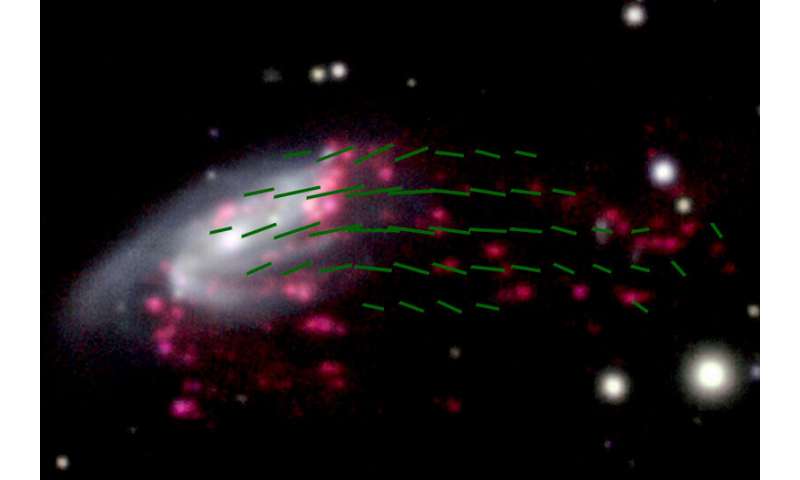The magnetic fields of the jellyfish galaxy JO206
OCTOBER 26, 2020
by Ruhr-Universitaet-Bochum

The galaxy JO206 and its ordered magnetic field (green lines) along the gas tail. Credit:ESO/GASP collaboration, adapted
An international team of astronomers has gained new insights into the physical conditions prevailing in the gas tail of so-called jellyfish galaxies. They are particularly interested in the parameters that lead to the formation of new stars in the tail outside the galaxy disk. They analyzed, for example, the strength and orientation of the magnetic fields in the galaxy JO206.
Ancla Müller and Professor Ralf-Jürgen Dettmar from Ruhr-Universität Bochum describe their findings together with Professor Christoph Pfrommer and Dr. Martin Sparre from the Leibniz Institute for Astrophysics in Potsdam as well as colleagues from the INAF—Italian national institute of Astrophysics in Padua, Selargius and Bologna in the journal Nature Astronomy from 26 October 2020.
Strong magnetic fields
Jellyfish galaxies are galaxies that fall into the center of a galaxy cluster, so that the motion pushes the interstellar gas in the opposite direction. This results in the formation of a tail, which gives these galaxies their jellyfish-like appearance and hence their name. A team led by Bianca Poggianti, one of the authors of the current paper from the INAF, had shown in earlier studies that stars can form in the gas tails of jellyfish galaxies. The fact that magnetic fields in galaxies can contribute to star formation is well known. However, it has not yet been established whether this is also the case in the rarified gas of jellyfish tails, which are difficult to study due to their low brightness.
The team headed by Ancla Müller has now taken a first step towards resolving this issue. The researchers analyzed the magnetic field structure of the galaxy JO206. They have shown that not only the galaxy disk has a strong magnetic field, but also the gas tail. "Considering the unusually high proportion of polarized radiation, we can conclude that the field is aligned very precisely along the tail," explains Ancla Müller.
More:
https://phys.org/news/2020-10-magnetic-fields-jellyfish-galaxy-jo206.html
